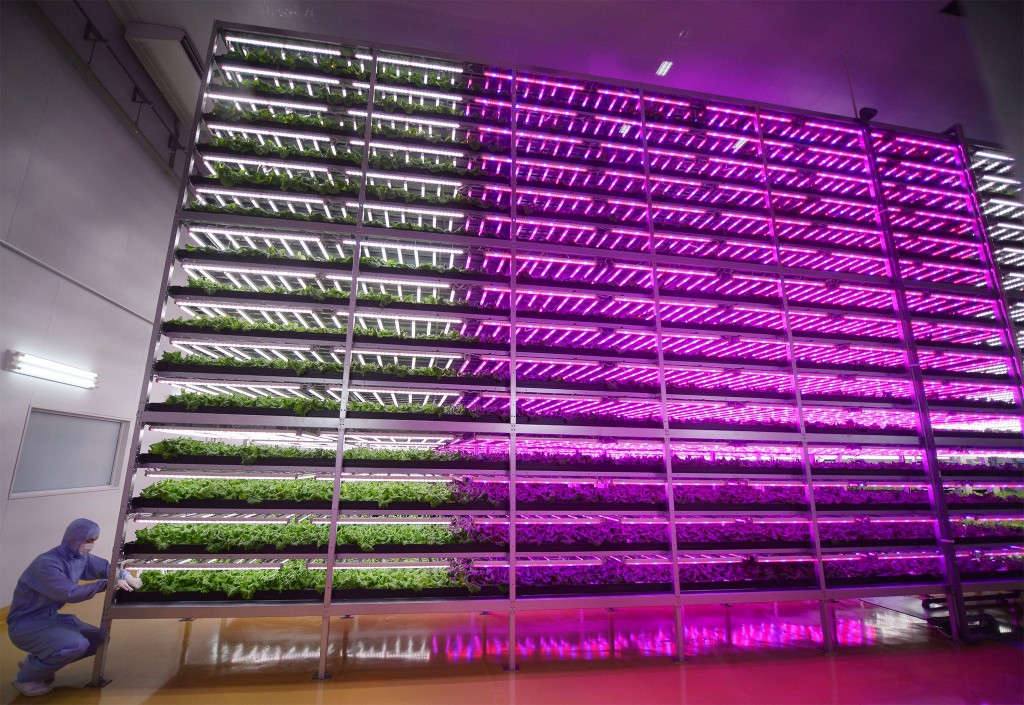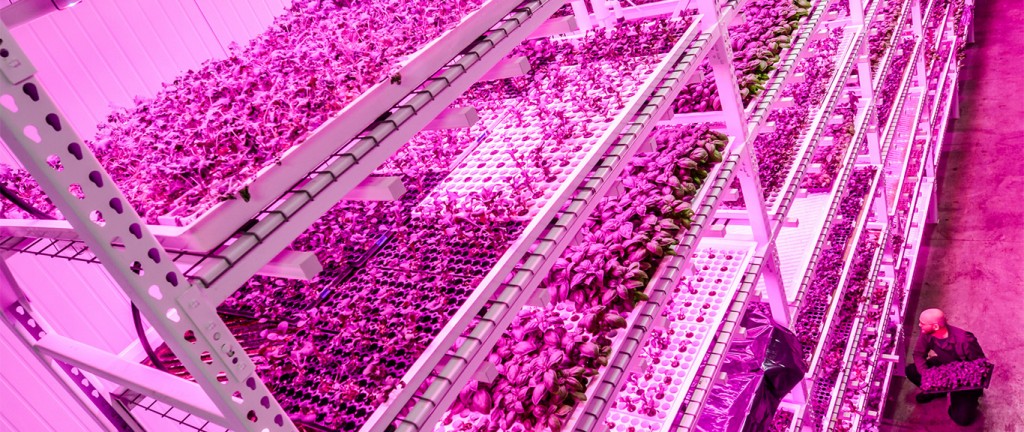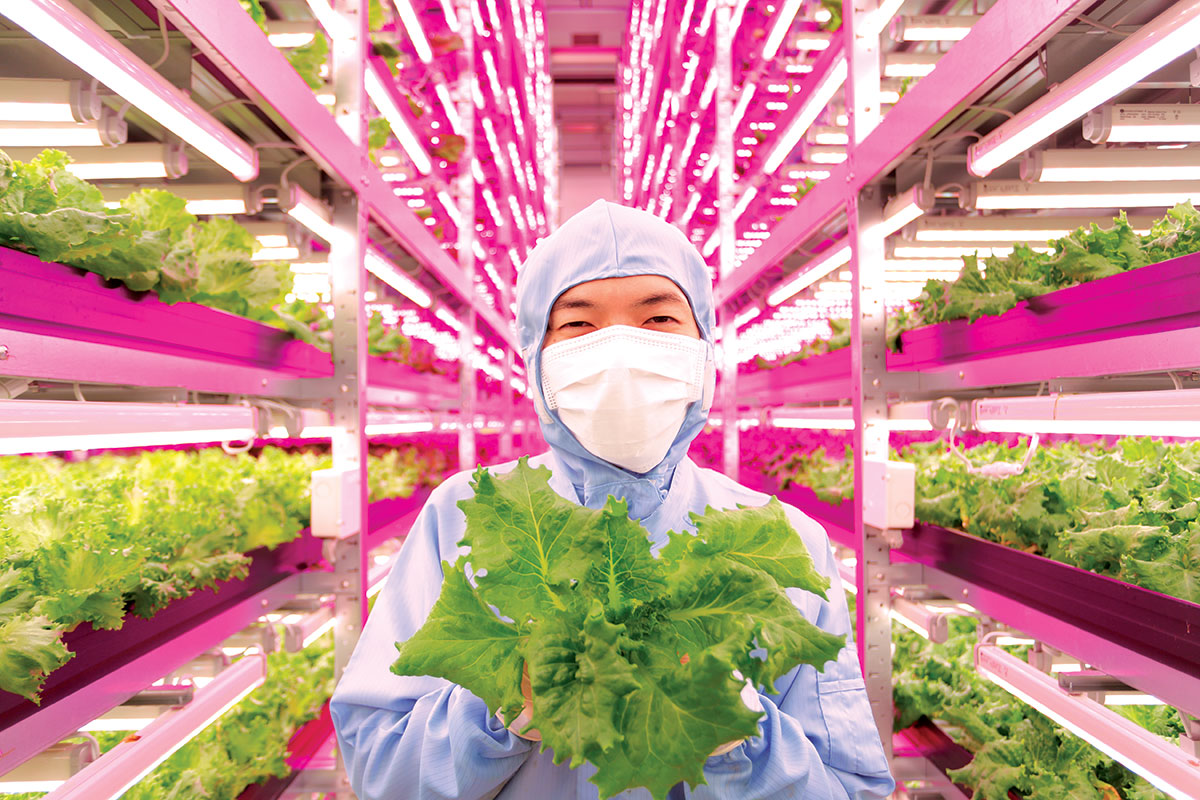In case you haven’t noticed, the world’s population is drastically moving. In two directions: upwards and inwards. By 2050 we will need to feed 9.6 billion people. A whopping 133% more than today’s 7.2 billion and 2200 times as many mouths than the population of New Zealand right now. It’s moving inwards too. Today, more than half of us live in densely populated urban environments. By 2050 66% (or 6.3 billion) of us will. This means one thing. An unprecedented demand for food – in urban areas.
A scary thought, given food production and agriculture are already shockingly taxing on the natural environment – and in many cases – our health too. From water, energy and land use to the nasty issues surrounding fertilizers and pesticides, transportation and waste, conventional agriculture is far from earth friendly.
So it comes as no surprise that safeguarding global food security and sustainability for 9.6 billion people will mean doing more with less. And with the masses moving into our city centres, it will also mean doing things differently. Vastly differently. Especially when it comes to producing land and resource intensive (water and fertilizer) staples like horticultural land-based foods, including leafy greens, fruit and veggies. Because, while we can 3D print and bioengineer almost anything now (including the recently hyped Impossible Burger and other forms of juicy beef patties and protein alternatives made from real bovine or plant cells), one hard fact remains. We aren’t making any more land. And 3D printing can only go so far.
Much like the changing dynamics of our population itself, this will likely mean moving arable crop production inward (i.e. into urban centres) – and more importantly upward (i.e. into the ether). Think high-rise urban indoor farming – on a mass scale. A mixture of hydro, aqua and aeroponics – and at lofty heights.
Some serious food for thought for New Zealand’s largely pasture and rural based agricultural and horticultural sectors valued at over 7.6 billion dollars – and nearly $4.3 of this export revenue (according to Industry publication Fresh Facts).
Data Science Meets Horticulture.
Indoor (and vertical) farms are essentially highly controlled and automated multi-level growing environments that use a combination of software analytics, energy efficient LED lighting, sensor controls and closed loop moisture and nutrient recirculation systems to allow growers to monitor, nourish and grow plants like lettuces, greens and even fruit now using a fraction of – or no- resources such as water, soil and environmentally dubious fertilizers and pesticides. All year round. 24 hours a day. No matter what season and without a drop of real sunlight in sight. Yes, the veritable disruption of traditional field ag as we know it. How will our Kiwi field growers cope with such significant technological and social change?
And before you naysayers out there think the world’s city dwellers will revolt at such a sterile, technologically complex concept such as industrial food production, think again. We’ve already seen how the “Impossible Burger” and Beyond Meat’s succulent meats range, including meatballs, patties and chicken strips are flying off the shelves in supermarkets throughout the States. Why would fruit and veg (which is actually the real thing) be any different? Something our traditional Kiwi horticultural farmers and the entire agricultural industry would be wise to take note of.
The arguments for high-rise farming are profound, to say the least. Indoor and vertical farming help to provide some very real and practical solutions to some of most pressing problems facing agriculture today, while being a highly profitable business model. And it’s happening already. In leaps and bounds.
Mirai, the world’s largest sensor-controlled hydroponic indoor vertical farm located in Japan, uses a closed nutrient recirculation system that requires 99% less water than traditional farming methods. Yes, 99% less. Spanning 25,000 square feet of vertical garden beds, its 17,500 energy efficient LED lights adapted with wavelengths to control the night-and-day cycle and accelerate growth mean highly productive and nutrient dense plants. 10,000 lettuces in a day productive – all bacteria and pesticide free.
AeroFarms and Green Sense Farms, two (of many) US based mass scale vertical farming companies making huge inroads in this emerging market are also yielding similar environmental benefits. AeroFarm’s custom UV light spectrums, endless patented growth algorithms and 30,000 data points monitored by plant scientists mean it is able to produce leafy greens, herbs and lettuces en mass, 24/7, using almost no traditional field inputs in sight – including soil. “We use about 95 percent less water to grow the plants, zero soil, about 50 percent less fertilizer as nutrients and zero pesticides, herbicide, fungicides,” says David Rosenburg, AeroFarm CEO and co-founder. “Plants don’t need soil, they need nutrients. And they don’t need sun, they need spectrum of light”. According to Rosenburg, plants receive the perfect amount of moisture and nutrients misted directly onto their roots in a completely controlled environment. Sacré Bleu!
And Green Sense Farm’s two industrial-sized, climate-controlled growing rooms outside of Chicago (each equipped with seven 12-meter tall grow towers) have over 14,000 LEDs that require less climate control, use less energy and absolutely no GMOs. Its cool burning green LED production modules mean lights can be placed closer to the plants, allowing for more levels to be stacked and more bang for your energy buck.
Critics of vertical farming worry that the energy use involved in such growing techniques might increase the carbon footprint by an order of magnitude. However, with the energy efficiency of LED lighting increasing exponentially, and as solar powered renewable energy is rapidly reaching mainstream in major markets globally, this trepidation might become redundant before we know it.
In world with a constantly growing base of discerning consumers concerned about environmental and sustainability impacts of the food they are consuming, how will Kiwi field farmers compete with such staggeringly impressive resource efficiencies?

The Sky’s your Limit
But if environmental benefits aren’t enough to convince you of the real value of vertical farming then the numbers probably will. According to Caleb Harper, principal research scientist for the Open Agriculture (OpenAG) Initiative and CityFarm at MIT’s Media Lab, 30-40% of our diet (including greens, tomatoes and capsicums) could be produced in urban or peri-urban environments in the very near future – and it would be a lot better for us if it was.
Dubbed the “Vegetable Factory” of Japan, Mirai’s completely automated (including humidity, temperature, CO2, and irrigation) multi-level system spanning half the size of a football field is already 100 times more productive per square foot than traditional methods.
Rosenburg says AeroFarm’s indoor leafy crops grow twice as fast as regular field seeds inside its controlled environment and the company has specifically designed customisable stackable modules to get even more greens per square foot. At 12 levels high, this means crop yields that are 75 times greater per square foot than traditional field methods annually. What’s more, AeroFarm’s newest operation built in Newark, New Jersey, spans 70,000 square feet (6,503 square meters) of growing space 30 feet high – double that of its smaller (already productive) farms and leading Japanese competitors. “It has the capacity to grow just under 2 million pounds of baby greens annually” says Rosenburg.
Significant vertical economies also allow companies like AeroFarms to spread out operational costs (like HVAC, lighting and rent) amongst a much larger product base as well as reduce the cost of goods sold to the end consumer. “We sell at the same price that supermarkets buy from field farmers in the category of organics which is typically about a 20% premium” says Rosenburg. With layer after layer of thriving verdant greens sprouting day in – day out, the company says it is already cash-flow positive.
And Green Sense Farms’ unique vertical stacking system in its 30,000-square foot (2,800 square metre) Chicago facility can distribute produce within 100 miles to over 20 million people. “At capacity, we’re producing about three to four million pounds of fresh produce a year” says CEO Robert Colangelo.
Figures not to be sniffed at by even the most productive of Kiwi growers. Such unheard of levels of food productivity (volume) using a relatively miniscule footprint of land will be a godsend when considering the 9 billion people we’ll soon be having to cater for.
What’s more, thanks to exponential improvements in robotics technology, Mirai and US vertical farms, including FarmedHere, along with AeroFarms, Green Sense Farms and Spread are also developing the technology to become robot-run farms devoid of human error. With Mirai already (human) hand harvesting over 10,000 heads of fresh lettuce, the mind boggles at just how many more greens these companies will be able to produce with robots in tow.
Tastebuds Gone Wild
Still not sold? Controlled indoor farms (vertical included) – also mean crops are protected from insects, diseases and aren’t exposed to brutal weather conditions like drought and flooding – the bane of many farmers’ existence – making toxic chemical use and crop yield instability a thing of the past for growers. And for the consumer, this means healthy and nutritious food. Indoor farms like Aero, Mirai and Green Sense are entirely pesticide, herbicide, insecticide and fungicide free. Good news for health-conscious punters like me, since the last time I checked, no one wants to order a side of herbicide or chemicals with their salad.
AeroFarms have taken this one step further by focusing as much on consumer nutrition as it does on low environmental impact. Greens are scrupulously macro & micro monitored for nutrient density, providing all the minerals and vitamins you could ask for. And the customers are lapping it up. Even top upmarket US restaurateurs, who would once have shunned the idea of buying indoor crops as part of their chic garden to table, local produce offerings, are sold on the stuff. “They taste the way greens are supposed to taste, the way I remember them tasting as a kid. There’s a flavour profile and if you put them up against greens from another big supplier, there’s no comparison in the freshness factor and in visual appeal” says Steven Yglesias, owner of a popular restaurant in Newark’s Ironbound neighbourhood.
No Nasty Food Miles
But perhaps one of the biggest advantages of vertical farming, at least when it comes to feeding the urban masses, is that you can build an indoor farm anywhere and to whatever size and height you want (within city limits). Without a ray of sun or speck of fertile NZ soil in sight. The sky’s your limit – quite literally. Mirai’s plant factory is located in an old semi conductor factory in eastern Japan’s Miyagi Prefecture – close to masses of urban mouths. Green Sense Farm’s green bounty is grown beneath 30 foot ceilings in a leased warehouse centrally located in an industrial park 40 miles outside of Chicago, a massive food distribution hub. And AeroFarm’s 9th domestic facility (yes 9th!) was built in a nondescript former paintball and laser tag facility in Newark, NY.
It also opens up the whole “buy local and fresh” model to the masses, traditionally a luxury only for the higher income earning echelons of society. Consumers everywhere will soon be able to eat nutrient dense fresh produce without the food miles. “When we build a farm, we become a part of the local community, bringing new life, to old buildings and reducing transportation miles” says Rosenburg.
Which begs the million-dollar question for our ag industry: Why buy clean green Kiwi produce when you can buy local and environmentally benign alternatives with no food miles attached? With indoor farms being built inside of, or in the fringes of massive cities, the need to transport (what once was) fresh and highly perishable farm produce (often) thousands of kilometres to urban consumers becomes close to ZERO. A huge plus for consumers and the environment, given the Tesla of the trucking world and mass scale electric transportation logistics have yet to reach mainstream.
Moreover, what happens to our horticultural exports altogether (to the tune of $4.27 billion plus in 2015) as companies like Green Sense and AeroFarms rapidly gain stronger footholds in the lucrative markets we sell into? Green Sense has already signed a partnership to operate 20 mass scale vertical operations in China. The first farm is set to produce 750,000 to 1 million heads of lettuce and about 1.5 million leafy greens per year.
Of course, not all of New Zealand’s horticultural exports are leafy greens suitable for inner city high rises. We export far more palatable plant based goodness than this. But it does beg the question as to how such technologies and bioscience could potentially disrupt these profitable hort subsectors too, and in a way that could possibly erode all our field pasture competitiveness we have steadily worked on over time. Our vital export revenue mainstay may be given a hideous shake up. Whether we like it or not.

Where to for Kiwi growers?
With stats like this, it is clear that vertical farming could play a key role in helping to avert a looming global food and environmental crisis – and one day become the future of agriculture. And with good reason.
The unheard of volume (productivity) of nutritious food that can be produced locally on the same footprint of land using a fraction of resources will be vital for feeding the 9 billion mouths we’ll soon have to cater for. And for areas where extreme weather conditions and resource scarcity routinely threaten their agricultural livelihood (think the sub-Saharan Africa, Middle East, United States and Southeast Asia) indoor farming techniques will very likely rise to vertical heights.
The question New Zealand now needs to ask itself is: As agrarian outdoor growers, what is our role in this rapidly changing new indoor, urban food producing dynamic? Yes, vertical farming may presently have found a niche in producing smaller lightweight crops that don’t require a huge amount of indoor real estate, all of which affords our fruit and larger crop growers some breathing space. For now. But we all know how quickly technologies can develop to shake up the status quo and erode industries overnight. Do we need to shift our focus away from bulky crops ill-suited to indoor warehouses for the future, or should we focus on plant varietals that labs and technology simply won’t be able to mimic in an indoor setting? Do we need to be riding on the coat tails of indoor farming’s technological success by investing in similar operations and technology? Or does New Zealand need to give up the ghost completely, let go of our entrenched desire to be leaders in agriculture and focus on new industry development altogether?
The answers remain to be seen. But such questions are highly worthy of asking – and planning for – right now.



Leave a comment